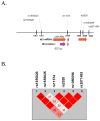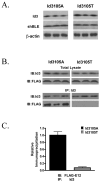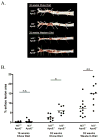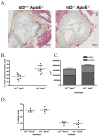Id3 is a novel atheroprotective factor containing a functionally significant single-nucleotide polymorphism associated with intima-media thickness in humans
- PMID: 20185798
- PMCID: PMC2860382
- DOI: 10.1161/CIRCRESAHA.109.210294
Id3 is a novel atheroprotective factor containing a functionally significant single-nucleotide polymorphism associated with intima-media thickness in humans
Abstract
Rationale: The gene encoding the helix-loop-helix transcription factor Id3 (inhibitor of differentiation-3) is located within atherosclerosis susceptibility loci of both mice and humans, yet its influence on atherosclerosis is not known.
Objective: The present study sought to determine whether polymorphisms in the ID3 gene were associated with indices of atherosclerosis in humans and if loss of Id3 function modulated atherogenesis in mice.
Methods and results: Six tagging single-nucleotide polymorphisms (SNPs) (tagSNPs) in the human ID3 gene were assessed in participants of the Diabetes Heart Study. One tagSNP, rs11574, was independently associated with carotid intima-media thickness (IMT). The human ID3 variant at rs11574 results in an alanine to threonine substitution in the C terminus. To determine the effect of this polymorphism on the basic function of Id3, site-directed mutagenesis of the human ID3 gene at rs11574 was performed. Results demonstrated a significant reduction in coimmunoprecipitation of the known E-protein partner, E12, with Id3 when it contains the sequence encoded by the risk allele (Id3105T). Further, Id3105T had an attenuated ability to modulate E12-mediated transcriptional activation compared to Id3 containing the ancestral allele (Id3105A). Microarray analysis of vascular smooth muscle cells from WT and Id3(-/-) mice revealed significant modulation of multiple gene pathways implicated in atherogenesis. Moreover, Id3(-/-)ApoE(-/-) mice developed significantly more atherosclerosis in response to 32 weeks of Chow or Western diet feeding than Id3(+/+)ApoE(-/-) mice.
Conclusions: Taken together, results provide novel evidence that Id3 is an atheroprotective factor and link a common SNP in the human ID3 gene to loss of Id3 function and increased IMT.
Conflict of interest statement
Figures





Similar articles
-
Helix-loop-helix factor inhibitor of differentiation 3 regulates interleukin-5 expression and B-1a B cell proliferation.Arterioscler Thromb Vasc Biol. 2013 Dec;33(12):2771-9. doi: 10.1161/ATVBAHA.113.302571. Epub 2013 Oct 10. Arterioscler Thromb Vasc Biol. 2013. PMID: 24115031 Free PMC article.
-
A functionally significant polymorphism in ID3 is associated with human coronary pathology.PLoS One. 2014 Mar 6;9(3):e90222. doi: 10.1371/journal.pone.0090222. eCollection 2014. PLoS One. 2014. PMID: 24603695 Free PMC article.
-
Increased 12/15-lipoxygenase enhances cell growth, fibronectin deposition, and neointimal formation in response to carotid injury.Arterioscler Thromb Vasc Biol. 2011 Jan;31(1):110-6. doi: 10.1161/ATVBAHA.110.212068. Epub 2010 Oct 14. Arterioscler Thromb Vasc Biol. 2011. PMID: 20947825 Free PMC article.
-
Genetic effects on carotid intima-media thickness: systematic assessment and meta-analyses of candidate gene polymorphisms studied in more than 5000 subjects.Circ Cardiovasc Genet. 2010 Feb;3(1):15-21. doi: 10.1161/CIRCGENETICS.108.834366. Epub 2009 Dec 11. Circ Cardiovasc Genet. 2010. PMID: 20160191
-
Id3, E47, and SREBP-1c: fat factors controlling adiponectin expression.Circ Res. 2008 Sep 12;103(6):565-7. doi: 10.1161/CIRCRESAHA.108.184366. Circ Res. 2008. PMID: 18796641 Free PMC article. Review. No abstract available.
Cited by
-
Helix-loop-helix factor inhibitor of differentiation 3 regulates interleukin-5 expression and B-1a B cell proliferation.Arterioscler Thromb Vasc Biol. 2013 Dec;33(12):2771-9. doi: 10.1161/ATVBAHA.113.302571. Epub 2013 Oct 10. Arterioscler Thromb Vasc Biol. 2013. PMID: 24115031 Free PMC article.
-
E Proteins and ID Proteins: Helix-Loop-Helix Partners in Development and Disease.Dev Cell. 2015 Nov 9;35(3):269-80. doi: 10.1016/j.devcel.2015.10.019. Dev Cell. 2015. PMID: 26555048 Free PMC article. Review.
-
Heartbreakers or Healers? Innate Lymphoid Cells in Cardiovascular Disease and Obesity.Front Immunol. 2022 May 11;13:903678. doi: 10.3389/fimmu.2022.903678. eCollection 2022. Front Immunol. 2022. PMID: 35634348 Free PMC article. Review.
-
ID3 regulates the MDC1-mediated DNA damage response in order to maintain genome stability.Nat Commun. 2017 Oct 12;8(1):903. doi: 10.1038/s41467-017-01051-z. Nat Commun. 2017. PMID: 29026069 Free PMC article.
-
Review of the Diabetes Heart Study (DHS) family of studies: a comprehensively examined sample for genetic and epidemiological studies of type 2 diabetes and its complications.Rev Diabet Stud. 2010 Fall;7(3):188-201. doi: 10.1900/RDS.2010.7.188. Epub 2010 Nov 10. Rev Diabet Stud. 2010. PMID: 21409311 Free PMC article. Review.
References
-
- Geng YJ, Libby P. Progression of atheroma: a struggle between death and procreation. Arteriosclerosis, thrombosis, and vascular biology. 2002;22:1370–1380. - PubMed
-
- Stary HC. Natural history and histological classification of atherosclerotic lesions: an update. Arteriosclerosis, thrombosis, and vascular biology. 2000;20:1177–1178. - PubMed
-
- Berenson GS, Srinivasan SR, Bao W, Newman WP, 3rd, Tracy RE, Wattigney WA. Association between multiple cardiovascular risk factors and atherosclerosis in children and young adults. The Bogalusa Heart Study. N Engl J Med. 1998;338:1650–1656. - PubMed
-
- Lusis AJ, Mar R, Pajukanta P. Genetics of atherosclerosis. Annu Rev Genomics Hum Genet. 2004;5:189–218. - PubMed
Publication types
MeSH terms
Substances
Grants and funding
- R01 HL62522/HL/NHLBI NIH HHS/United States
- F32 HL085989/HL/NHLBI NIH HHS/United States
- 5-T32 HL007355-29/HL/NHLBI NIH HHS/United States
- R01 HL067348/HL/NHLBI NIH HHS/United States
- R01 HL136098/HL/NHLBI NIH HHS/United States
- M01 RR007122/RR/NCRR NIH HHS/United States
- P01 HL55798/HL/NHLBI NIH HHS/United States
- R01 HL062522/HL/NHLBI NIH HHS/United States
- T32 HL007355/HL/NHLBI NIH HHS/United States
- R01 HL67348/HL/NHLBI NIH HHS/United States
- M01 RR07122/RR/NCRR NIH HHS/United States
- P01 HL055798/HL/NHLBI NIH HHS/United States
LinkOut - more resources
Full Text Sources
Medical
Molecular Biology Databases
Miscellaneous

